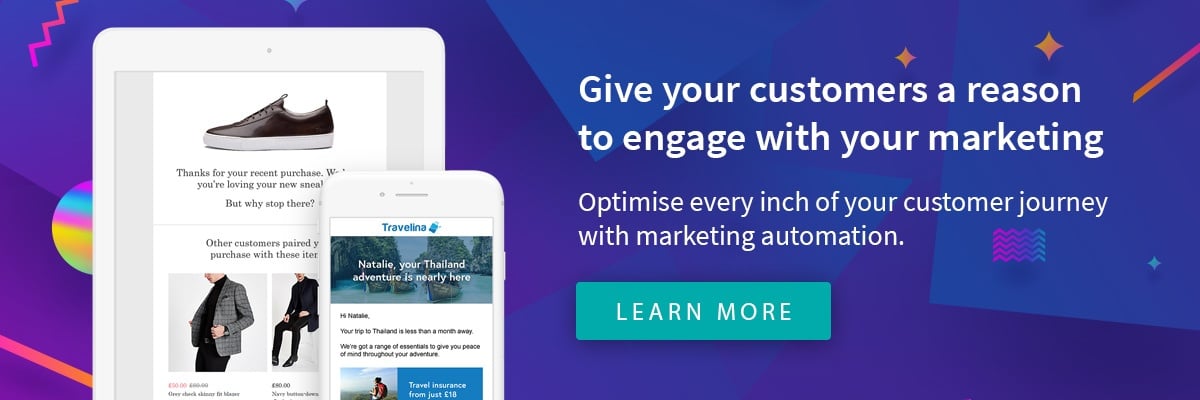Effective personalisation is only ever as good as the quality and breadth of your data.
Disparate data and incomplete records leave many businesses unable to join up the dots and build meaningful customer segments. Without these, personalisation may be a wasted effort.
The answer? A single customer view made possible by a customer data platform (CDP). In this blog post we explain what CDP is and why you need one.
What is a Customer Data Platform?
A customer data platform (CDP) is a piece of technology that provides a single view of all your customer data. It does away with silos and brings together data from every customer service and marketing channel your business has.
A CDP brings together:
- online transactions
- in-store purchases
- demographics
- location
- website behaviour
- email engagement
The aim of a CDP is to enable true cross-channel personalisation and customer journeys. To provide the fully rounded view of your customers needed to do this, it integrates with your existing CRM. This allows you to analyse and act on everything you’ve learned about your customers, in one place.
Implementing a CDP ensures your personalisation efforts are based on a comprehensive understanding of how your customers behave. Increased engagement and conversions are a natural result.
Benefits of a Customer Data Platform
There are a number of benefits of a CDP. To help you build a business case, we explore each one in this section.
Saving time
Having a CDP saves time. Taking different data points from multiple marketing and customer service channels is time-consuming and cumbersome.
A CDP integrates with your CRM and multiple other channels, bringing together all your data automatically. This makes a single customer view accessible instantly.
Working with big data
Working with large datasets is tricky at the best of times. But in some instances what you hope to achieve might not even be possible without a CDP.
Spreadsheet applications like Excel are great to manipulating small datasets, but if you’re working with big data you’re going to find it extremely difficult to do basic filtering. You’ll likely run into memory issues, errors and slow down. Excel might even grind to a complete halt as it struggles under the weight of your data.
Excel also has limits on the number of columns and rows. This means you’ll need to split your database multiple times and repeat the same task over and over.
How do we define big data?
If you’ve got over 100,000 contacts in your database then you’re definitely going to need to upgrade from a spreadsheet to a CDP.
Avoiding personalisation fails
When you try something clever with personalisation—but get key information wrong—the relationship you’ve been trying to nurture sours.
For example, you may email product recommendations that include something your customer just bought in store.
Without a CDP, there is a real risk of this happening.
This kind of personalisation fail makes it clear to the customer that your messages are automated. Not only may this irritate them, but it could make them less likely to continue engaging with your business.

A CDP combines in-store and online data to give you an accurate view of your customers purchase history across clicks and bricks.
Matching multiple data points about one customer
When you have a bunch of disparate data sources, you can end up with duplicate records for the same customer. Each may contain parts of the puzzle that need to be pieced together to personalise for them in a meaningful way.
A CDP joins the dots for you, matching customer identities from different devices and channels. It combines this with real-time website and in-store data to gives you an accurate, up to date view of your customers in one place.
Analysing your audience
A CDP gives you instant access to consolidated cross-channel data, meaning you can analyse consumer behaviour and answer key questions about your audience.
For example:
- Who are your most loyal customers?
- Which products are popular with certain demographics?
- Who hasn’t made a purchase recently?
- Which customers are coming to the end of their subscription?
Building real-time behavioural segments
When it comes to personalisation, a CDP means you can build segments that are based on real-time behavioural data.
This advanced segmentation is the cornerstone of behavioural marketing. It ensures customers receive timely, contextually relevant messages that they find engaging.
Increasing revenue
A CDP allows you to get much more intelligent about the way you personalise. This improves customer experience and increases conversions.
Not only this, but next-level personalisation makes consumers feel more connected to your brand. This builds loyalty and boosts customer lifetime value.
In these ways, a CDP allows you to make more money from your website.
Improving reporting
A CDP also allows you to measure and report on ROI more easily. Having cross-channel data in one place makes calculating customer lifetime value much simpler.
When you don’t have to spend ages creating reports, you have more time to analyse them. This allows you to pinpoint areas to improve, so you can continually build on your success.
Predicting and shaping behaviour
The results a CDP can deliver are impressive from the outset but improve with use. The sky’s the limit.
The technology makes use of machine learning that understands more about your customers over time. This allows you to predict and shape consumer behaviour, driving up profits at every stage of the customer journey.
Takeaway
A customer data platform (CDP) allows you to access, analyse, and act on everything you know about your customers. This means you can do more with your data and personalise your marketing in increasingly nuanced and effective ways.
The results are improved customer experiences, more conversions, increased customer loyalty, and more revenue.
Without a customer data platform (CDP), it is hard for marketers to reach their full potential.
Find out more about our own customer data platform – PureIntelligence.

